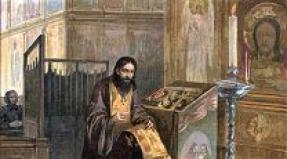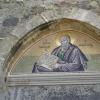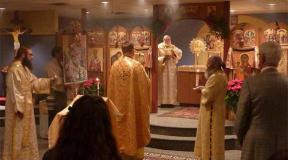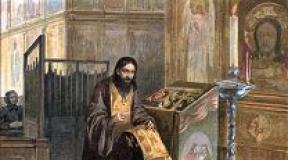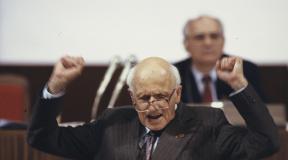Holy Apostle and Evangelist John the Theologian. John the Theologian: The Repose of the Apostle John the Theologian - victory over corruption
Among the books of Holy Scripture given to people by the Lord through his disciples, the Apocalypse stands out especially. It talks about the “end of times” that awaits humanity as a result of their sinful lifestyle. The author of the Apocalypse is the Apostle-Evangelist John the Theologian (another title of the book directly indicates this - “The Revelation of the Holy Apostle John the Theologian”). The Lord chose this man to carry a warning to all the inhabitants of the Earth. The Church established the date of memory of John the Theologian on May 21 (May 8 according to the old style), the day of his death.
The Beginning of Serving Christ
On the day of remembrance of the holy apostle, let's take a closer look at the life of John the Theologian.
John the Theologian was the son of the daughter of St. Joseph the Betrothed from his first marriage, Salome and a Christian named Zebedee. The apostle was also the brother of Saint James and the nephew of Christ himself. John the Theologian became one of the disciples of Jesus by following the call of the Son of God on Lake Gennesaret. He set out on the path of faith together with his brother. It was Saint John who became one of the three disciples closest to Christ and witnessed many signs and wonders performed by the Savior during his lifetime. It was he who asked Jesus a question during the Last Supper about who would betray the Teacher, and also one of all the apostles did not hide at the moment of the crucifixion of the Messiah on the cross and cared, by the will of the one who sacrificed himself for the salvation of mankind, about the Mother of God until the Dormition of the Most Pure One.
According to the lot, designed to determine for each disciple the land of Christ to carry out preaching activities there, John the Theologian had to follow to Asia Minor. In order to get to the place, the apostle had to travel by sea, which he was incredibly afraid of. Therefore, when all the disciples got ready to set off, John remained with the Virgin Mary in Jerusalem, where he stayed until the 50th year. But he still had to sail to Asia Minor, and when this happened, the ship on which Christ’s disciple was sailing was wrecked. However, no one died, and even the apostle himself, who had gone missing, was later miraculously carried by a wave to land unharmed.

Arriving in Ephesus together with his disciple Prochorus, John the Theologian became a victim of oppression by a local resident, Romana. However, God interceded for his charges: very quickly the conflict was resolved, and the evil woman and two men saved through the prayers of the apostles accepted Christian Baptism. At the fiery request of John, the Lord showed terrible signs to the pagans who were raging in the city, in order to convert them to the true faith. This helped, and thousands of people left the fold of paganism. Unfortunately, Emperor Domitian learned about what had happened, in particular about the destruction of the ancient temple by an earthquake caused by the apostle’s prayers to the one Lord. He ordered the preacher to be seized, and seeing the disciple Jesus in person, he sentenced the unfortunate man to death. However, it was not so easy to kill a person under the protection of God. The poison drunk by the apostle did not have the slightest effect on him, and the boiling oil in the cauldron into which John the Theologian was thrown afterwards did not harm the saint’s body. As a result, Domitian exiled the righteous man to the island of Patmos, deciding that he was immortal.
The path to the island lay across the sea. During the journey, John had the opportunity to convert the guards accompanying him to God. Through the prayers of the saint, a man who had fallen overboard was saved, the crew quenched their thirst with fresh water, and a patient with dysentery was healed. Seeing such miracles, the guards wanted to release the apostle, but he resisted. Then they stayed next to the disciple of Jesus on Patmos for 10 days, as a result of which they received holy Baptism and became Christians.
While in exile, the apostle did not stop performing miracles. John cast out a demon from the young man, the son of a resident of the city of Flora, eventually baptizing the victim himself and his entire family; exposed the pagan sorcerer Kinops; raised children and adults from the dead; healed women from infertility; delivered the despairing from despondency and unbelief. With his fiery prayers, he destroyed the temples of Dionysus and Apollo on the island and converted almost all the inhabitants of Patmos to the path of Christianity.

Voice from the sky
In 96, power changed: Emperor Nerva ascended the throne, because the previous ruler was killed. The new king had no desire to persecute Christians and hinder the spread of their faith. Moreover, he freed John the Theologian, and he, having received a vision from the Lord, prepared to sail with Prochorus to Ephesus. The inhabitants of Patmos were saddened to learn about this and turned to the apostle with a request to leave them a written version of the Word of God. This is how the world-famous Gospel of John appeared, transmitted to people by the Lord. The holy apostle spoke, and his companion wrote down the message for two days. They ended up with two copies of the Gospel: they left one for the inhabitants of the island, and took the other with them.
According to Holy Tradition, the Apocalypse was recorded by Prokhor from the words of John there. This was preceded by a ten-day fast of the apostle in prayer and solitude, living in a cave. In the latter, John the Theologian heard the voice of heaven about the events that people should expect at the “end of times.” This cave today is located under the buildings of the Monastery of the Apocalypse and is a church in the name of the Apostle John the Theologian. “Revelation” is rightfully considered the most mysterious book in the world, because all the information in it is encrypted in figurative expressions and mysterious hints.
Last years of life and death
So Saint John returned to Ephesus and stayed in the house of a young man named Domnus, whom he had once raised from the dead. Afterwards the apostle was greeted quite cordially by this man many times. John the Theologian continued to travel through the cities of Asia Minor and preach the Word of God. During these campaigns, he baptized many people.

At the end of his life, Saint John the Theologian became an even greater ascetic than ever. He spent days and nights in deep abstinence, rejecting any food except water and bread. Already in complete old age and weakness, John the Theologian instructed bishops, and repeated only one thing to his disciples: “Children, love one another.” It must be said that throughout his entire earthly existence he taught people peace; that’s what they call him today: “the apostle of love.” At the age of 95, the holy apostle received a revelation from God, from which he learned that he would soon die. Then he gathered seven of his disciples, early in the morning he went with them to a field outside the city, ordered to dig a grave in the form of a cross, lay down in it and asked them to cover themselves with earth up to their necks, and cover their heads with a thin cloth. The disciples obeyed, said goodbye to John and were sent back to the city by him. Returning to Ephesus, they reported what had happened to the Christian residents. They were saddened and wanted to see the elder’s grave. When we found ourselves on the spot with the disciples, we saw that it was... empty.
For many years, the grave of John the Theologian exuded fragrant myrrh. People who collected it received healing from mental and physical ailments. Today, the holy apostle is considered their patron by subjects whose professional activities are in one way or another connected with writing: authors, publishers and editors. This is not surprising, because John the Theologian gave humanity, by the will of God, the most important written sources of the Lord's truth...
The holy apostle and evangelist John the Theologian was the son of Zebedee and Salome, the daughter of St. Joseph the Betrothed. At the same time as his elder brother Jacob, he was called by our Lord Jesus Christ to be one of His disciples on Lake Gennesaret. Leaving their father, both brothers followed the Lord.
The Apostle John was especially loved by the Savior for his sacrificial love and virginal purity. After his calling, the apostle did not part with the Lord and was one of the three disciples whom He especially brought close to Himself. Saint John the Theologian was present at the resurrection of the daughter of Jairus by the Lord and witnessed the Transfiguration of the Lord on Tabor. During the Last Supper, he reclined next to the Lord and, at a sign from the Apostle Peter, leaning against the Savior’s chest, asked about the name of the traitor. The Apostle John followed the Lord when He, bound, was led from the Garden of Gethsemane to the trial of the lawless high priests Annas and Caiaphas, but he was in the bishop's courtyard during the interrogations of his Divine Teacher and relentlessly followed Him along the Way of the Cross, grieving with all his heart. At the foot of the Cross, he wept together with the Mother of God and heard the words of the Crucified Lord addressed to Her from the height of the Cross: “Woman, behold Thy son,” and to him: “Behold Thy Mother” (John 19, 26, 27). From that time on, the Apostle John, like a loving son, took care of the Blessed Virgin Mary and served Her until Her Dormition, never leaving Jerusalem. After the Dormition of the Mother of God, the Apostle John, according to the lot that fell to him, went to Ephesus and other cities of Asia Minor to preach the Gospel, taking with him his disciple Prochorus. They set off on a ship that sank during a strong storm. All travelers were thrown onto land, only the Apostle John remained in the depths of the sea. Prochorus wept bitterly, having lost his spiritual father and mentor, and went to Ephesus alone. On the fourteenth day of his journey, he stood on the seashore and saw that a wave had thrown a man onto the shore. Approaching him, he recognized the Apostle John, whom the Lord kept alive for fourteen days in the depths of the sea. The teacher and student went to Ephesus, where the Apostle John constantly preached to the pagans about Christ. His preaching was accompanied by numerous and great miracles, so that the number of believers increased every day. At this time, the persecution of Christians began under Emperor Nero (56 - 68). The Apostle John was taken to Rome for trial. For confessing faith in the Lord Jesus Christ, the Apostle John was sentenced to death, but the Lord preserved His chosen one. The apostle drank the cup of deadly poison offered to him and remained alive, then emerged unharmed from the cauldron of boiling oil, into which he was thrown on the orders of the tormentor. After this, the Apostle John was sent into captivity on the island of Patmos, where he lived for many years. Along the way to the place of exile, the Apostle John performed many miracles. On the island of Patmos, a sermon accompanied by miracles attracted all the inhabitants of the island to him, whom the Apostle John enlightened with the light of the Gospel. He cast out numerous demons from idol temples and healed a great many sick people. The Magi, through various demonic obsessions, offered great resistance to the preaching of the holy Apostle. Particularly terrifying to everyone was the arrogant sorcerer Kinops, who boasted that he would bring the apostle to death. But the great John - the Son of Thunder, as the Lord Himself called him, by the power of the grace of God acting through him, destroyed all the demonic tricks that Kinops hoped for, and the proud sorcerer died ingloriously in the depths of the sea.
The Apostle John retired with his disciple Prochorus to a deserted mountain, where he imposed a three-day fast on himself. During the apostle’s prayer, the mountain shook and thunder roared. Prokhor fell to the ground in fear. The Apostle John raised him up and ordered him to write down what he would say. “I am Alpha and Omega, the firstfruits and the end, says the Lord, who is and who is and who is to come, the Almighty” (Rev. 1:8), proclaimed the Spirit of God through the holy Apostle. So, around the year 67, the Book of Revelation (Apocalypse) of the holy Apostle John the Theologian was written. This book reveals the secrets of the fate of the Church and the end of the world.
After a long exile, the Apostle John received freedom and returned to Ephesus, where he continued his work, teaching Christians to beware of false teachers and their false teachings. Around 95, the Apostle John wrote the Gospel in Ephesus. He called on all Christians to love the Lord and each other and thereby fulfill the commandments of Christ. The Church calls St. John the Apostle of Love, for he constantly taught that without love a person cannot approach God. The three Epistles written by the Apostle John speak about the meaning of love for God and others. Already in old age, having learned about a young man who had strayed from the true path and become the leader of a gang of robbers, the Apostle John went to look for him in the desert. Seeing the holy elder, the culprit began to hide, but the apostle ran after him and begged him to stop, promising to take upon himself the young man’s sin, if only he would repent and not destroy his soul. Touched by the warmth of the holy elder’s love, the young man truly repented and corrected his life.
The Holy Apostle John died at the age of over a hundred years. He far outlived all the other eyewitnesses of the Lord, for a long time remaining the only living witness of the earthly paths of the Savior.
When the time came for the Apostle John to depart to God, he withdrew outside of Ephesus with seven of his disciples and ordered a cross-shaped grave to be prepared for himself in the ground, in which he lay down, telling the disciples to cover him with earth. The disciples kissed their beloved mentor with tears, but, not daring to disobey, fulfilled his command. They covered the saint's face with a cloth and buried the grave. Having learned about this, the rest of the apostle’s disciples came to the place of his burial and dug up the grave, but found nothing in it.
Every year, from the grave of the Holy Apostle John on May 8th, fine dust came out, which the believers collected and were healed of their illnesses. Therefore, the Church celebrates the memory of the holy Apostle John the Theologian on May 8th.
The Lord gave his beloved disciple John and his brother the name “sons of thunder” - a messenger of heavenly fire, terrifying in its cleansing power. By this the Savior pointed to the fiery, fiery, sacrificial nature of Christian love, the preacher of which was the Apostle John the Theologian. The eagle is a symbol of the high soaring of Theological thought - the iconographic sign of the Evangelist John the Theologian. Of the disciples of Christ, the Holy Church gave the title of Theologian only to Saint John, the seer of the Destinies of God.
The Holy Apostle and Evangelist John the Theologian occupies a special place among the chosen disciples of Christ the Savior. Often in iconography, the Apostle John is depicted as a meek, majestic and spirit-bearing old man, with features of virginal tenderness, with the seal of complete calm on his forehead and the deep gaze of a contemplator of ineffable revelations
Another main feature of the spiritual appearance of the apostle is revealed through his teaching on love, for which he primarily received the title of Apostle of Love. Indeed, all his writings are permeated with love, the main idea of which boils down to the concept that God in His being is Love (1 John 4:8). In them he dwells primarily on the manifestations of God’s inexpressible love for the world and man, on the love of his Divine Teacher. He constantly exhorts his disciples to love each other.
The service of Love is the entire life path of the Apostle John the Theologian.
He was characterized by calmness and depth of contemplation combined with ardent loyalty, tender and boundless love with ardor and even some harshness. From the brief instructions of the Evangelists it is clear that he had an extremely ardent nature, his heartfelt impulses sometimes reached such violent jealousy that Jesus Christ was forced to moderate them, as disagreeing with the spirit of the new teaching (Mark 9, 38 - 40; Luke. 9; 49 - 50: Luke 9, 54 - 56) and called the Apostle John and his brother James “sons of thunder” (Boanerges).
At the same time, he reveals a rare modesty and, despite his special position among the apostles as a disciple whom Jesus loved, he did not stand out from the number of other disciples of the Savior. The distinctive features of his character were observation and receptivity to events, imbued with a subtle sense of obedience to the will of God.
Impressions received from outside were rarely found in his word or action, but penetrated powerfully and deeply into the inner life of the holy Apostle. Always sensitive to others, his heart ached for those who were perishing. The Apostle John listened with reverent awe to the God-inspired teaching of his Teacher, filled with grace and truth, contemplating in pure and sublime love the Glory of the Son of God. Not a single feature from the earthly life of Christ the Savior escaped the penetrating gaze of the Apostle John, not a single event passed without leaving a deep trace in his memory, therefore the entire fullness and integrity of the human personality was concentrated in him.
The thoughts of the Apostle John the Theologian had the same integrity. For him there was no duality. According to him, where there is no complete devotion, there is nothing. Having chosen the path of serving Christ, he pursued it with completeness and undivided consistency until the end of his life. The Apostle John speaks of complete devotion to Christ, of the fullness of life in Him, therefore he views sin not as weakness and corruption of human nature, but as evil, as a negative principle, completely opposite to good (John 8:34; 1 John 3, 4; 1 John 3, 8 - 9). In his opinion, one can belong either to Christ or to the devil; there can be no middle, indefinite state (1 John 2:22; 1 John 14:3). Therefore, he served the Lord with undivided love and dedication, rejecting everything that belonged to the original enemy of man, the enemy of truth and the founder of lies (1 John 2:21-22). The more he loves Christ, the more he hates Antichrist; the more he loves the truth, the more he hates lies - light excludes darkness (John 8:12; John 12:35 - 36). With this manifestation of the inner fire of love, he testified with special strength of spirit about the Divinity of Jesus Christ (John 1:1-18; 1 John 5:1-12).
The Apostle John was destined to express the last word of Divine Revelation, introducing the innermost secrets of the inner Divine life, known only to the eternal Word of God, the Only Begotten Son.
The truth is reflected in his mind and word, because he feels and comprehends it with his heart. He contemplates the eternal Truth and, as he sees it, passes it on to his beloved children. The Apostle John simply affirms or denies and always speaks with absolute accuracy (1 John 1:1). He hears the voice of the Lord, revealing to him what He Himself hears from the Father.
The theology of the Apostle John destroys the boundary between the present and the future. Observing the present, the temporal, he does not dwell on it, but transfers his gaze to the eternal in the past and to the eternal in the future. And therefore, calling for holiness of life, he solemnly proclaims that “whoever is born of God will not sin” (1 John 5:18; 1 John 3:9). In communion with God, a true Christian participates in the Divine life, therefore the future of humanity is already taking place on earth. In presenting and revealing the doctrine of the Economy of Salvation, the Apostle John the Theologian moves into the realm of the eternally present, in which Heaven has descended to earth and the renewed earth is illuminated by the Light of Heavenly Glory.
John the Theologian considered one of the most beloved and devoted students Christ, who preached the true faith until his death and relentlessly and faithfully followed the teacher all his life.
Life of the Apostle
John was the son fisherman Zebedee and one of the followers of Jesus Salome. Together with his older brother Jacob He was called by Christ to be one of His disciples and named “Son of Thunder” for his impetuous character.
According to the lot cast by all the Savior’s disciples, the apostle went to Ephesus (the territory of modern Turkey) for preaching purposes: thanks to him and his miracles, the number of believers increased every day.Roman Emperor Domitian Having learned about the destruction of the main Ephesian temple by a certain sorcerer, he ordered John to be seized, chained, beaten and then executed. The apostle was forced to drink poison, but it had no effect, he was thrown into a cauldron of boiling oil - John remained alive and unharmed. The emperor decided that John was immortal and sent him into exile on the island of Patmos, where he continued his preaching work and converted most of the local residents to Christianity.
Emperor Domitian was replaced Nerva, which did not interfere with the spread of Christianity, and John was released and returned to Ephesus. In subsequent years, he wrote the Gospel, in which he commanded Christians to love the Lord and each other, thereby fulfilling the law of Christ. That is why Saint John began to be called the apostle of love.
At the age of 95, John learned fromGentlementhat the days of his earthly life are numbered. Gathering his seven disciples before dawn, the apostle took them outside the city, prayed and asked them to dig up a grave in the shape of a cross, the length of his own height and, placing himself in it, ordered the disciples to “cover him with earth” up to his neck and leave. When the disciples, heeding the prayers of the Christians of Ephesus, led them to the grave, the apostle was not there. There is an opinion that the saint was taken to heaven along with his body, likeMother of Godand to the ancient righteous -Elijah And Enoch.
Icon “Apostle John the Theologian” (circa 1700), exhibition at the Museum of Russian Icon, 2011. Photo: RIA Novosti / Vladimir Vyatkin
In the Orthodox tradition, the Apostle John, along with Saint George And Simeon is called a “Theologian,” that is, an interpreter and defender of the doctrine of God, his activity in the world and revelation.
Miracles of John the Evangelist
One day, when John and his disciple were working in the Ephesian bathhouse, a certain young man died there, and after that his father also died of grief. The mistress of the bathhouse accused the apostle of murder, and then he resurrected both dead people.
While preaching, the crowd to which John was speaking stoned him, and he caused unbearable heat that killed 200 people. The crowd begged for mercy, and the apostle resurrected the dead.
On the way to the island of Patmos, the son of one of the royal nobles fell overboard and drowned. The next morning, John said a prayer, and a wave threw the young man onto the ship.
Thanks to the prayers of the apostle, the island of Patmos was freed from communication with unclean spirits Magus Kinops and his charms and atrocities.
Together with Peter And Jacob he was present at the resurrection daughters of Jairus, the transfiguration of Christ on Mount Tabor, the Lord’s prayer for the cup in the Garden of Gethsemane.
After the crucifixion of the Savior, he was the only one of the disciples who remained next to the Cross along with the Mother of God. Dying, Christ said that the Mother of God is the mother for John, and he becomes Her son. John took Blessed Virgin Mary to his home and took care of Her until Her Dormition.
He far outlived all the other eyewitnesses of the Lord and for a long time remained the only living witness to the earthly paths of the Savior.
How is the day of memory of John the Theologian celebrated?
On the day of the saint’s repose, you can attend a service in the church or at least visit the temple, read prayers to John the Theologian and light candles to his icon.Folk beliefs and signs
In the popular calendar, the day of St. John the Apostle is celebrated twice a year, calling Ivan of May the wheat worker, and Ivan of the Autumn the Theologian.
It is John who is considered the mentor of painting and icon painting: after all, he once turned a young man, herding geese, into a skilled painter, under his invisible patronage, handing him a letter of recommendation to the Constantinople court icon painter with a request to teach icon painting.
People say:
“If there is snow on the Theologian, then winter will fall on Michaelmas.”
*Michael's Day is the last autumn holiday in the folk calendar, associated with the end of the wedding season and celebrated on November 21.
Memorial Days:
May 21 (May 8, old style)- the day of the annual deposition of thin pink ashes at the site of his burial, which healed diseases;
July 13 (June 30) - the day of the Council of the Holy Glorious and All-Praised Twelve Apostles.
October 9 (September 26) – the day of the repose of the Apostle John
WHAT DOES THE HOLY APOSTLE AND EVANGELIST JOHN THE BOGOSLOV HELP WITH?
The Holy Apostle and Evangelist John is the patron saint of all those involved in the information sphere: publishers, writers working on the Internet.
The saint also received the nickname the apostle of love; prayers in front of his icon help to find good friends, find a strong family and subsequently protect it from quarrels, conflicts and from the evil intentions of other people.
Fishermen pray to the Apostle John for protection from accidents on the water and for a good catch.
It must be remembered that icons or saints do not “specialize” in any specific areas. It will be right when a person turns with faith in the power of God, and not in the power of this icon, this saint or prayer.
And .
THE LIFE OF THE APOSTLE JOHN THE GOLDEN
The holy apostle and evangelist John, together with his brother James, followed the Lord Jesus Christ when the Savior called them to follow him on Lake Gennesaret. The brothers left their father's house and became apostles, disciples of Christ, devoting their lives to Him.
John was not separated from the Teacher, he was one of the disciples close to Jesus, and witnessed many of His miracles. The holy apostle became one of three people who witnessed the Transfiguration of the Lord on Mount Tabor.

The disciple was with Jesus Christ and when He was captured and led to the judgment of iniquity, he followed Him along His Way of the Cross. He was nearby when the judges interrogated the Lord, all this time John's heart was full of sorrow. Weeping together with the Mother of God at the foot of the Cross, John was told the words of the Crucified Lord about his Mother:
“Behold your Mother” (John 19, 26, 27).
After the ascension of Christ, the Apostle John the Theologian, until the Assumption, was in Jerusalem, caring for the Mother of God, as a devoted and loving son.
After Saint Mary left earthly life, the Apostle John was given a lot, according to which he was to go preach the Gospel in Ephesus and other cities of Asia Minor.
Together with his student Prokhor, they boarded a ship that was caught in a storm and sank. All travelers were saved, except the Apostle John. Prokhor was very worried, because he had lost his mentor and spiritual father. He had to go to Ephesus alone. Prokhor walked along the seashore for about two weeks, and then one day he discovered a man lying by the water, whom he recognized as his mentor. John was on the open sea for fourteen days, but remained alive, God spared his life.
After all the adventures, which ended happily, the teacher and student headed together to Ephesus, where the apostle told the pagans about Jesus Christ. The number of people who began to believe in Christ increased literally every day, because during these sermons miracles often occurred, confirming his words about the Savior.
At the same time, by order of Emperor Nero (56 - 68), persecution began against people who accepted the Christian faith. The Apostle John was captured and taken to Rome for trial, where he was sentenced to death.
By order of the executioners, John was given a cup of poison to drink; after drinking the deadly drink, he remained alive - the Lord protected His disciple.
Then the apostle was thrown into a cauldron containing boiling oil, but he continued to live.
After these brutal trials, John was exiled to the island of Patmos (now a Greek island in the Aegean Sea), where he lived for many years.

On the island, the Apostle John continued to preach Christian teaching, which attracted local residents, and again miracles occurred during his sermons.
With God's help, he cast out demons from numerous idol temples and cured many sick people. Local sorcerers and sorcerers opposed the apostle in his teaching, but Saint John, with the help of God's grace sent down to him, destroyed all their demonic tricks.
One day, in order to undergo a three-day fast, the Apostle John and Prokhor went to a deserted mountain. When they began to read prayers, thunder roared, the mountain trembled, and Prokhor fell to the ground in fear. The Apostle John helped him get up and ordered him to write down what he would say.
“I am Alpha and Omega, the beginning and the end, says the Lord, who is and who is and who is to come, the Almighty” (Rev. 1:8).
With these words, the Holy Spirit of God spoke through the Apostle about the mysteries of the destinies of the Church and the end of the world, commanding that John write a Book about what he heard. So, around the year 67, the Book of Revelation (Apocalypse) was born.
The Apostle John was the fourth person to write the Holy Gospel; three Gospels had already been written before him. Having read the writings of other evangelists, he sees that they preach about the incarnation of Christ, but did not say anything clear and demonstrative about His eternal existence, therefore the Apostle John announces the birth of Christ on high. In his Gospel he explained and added what other evangelists said unclearly or kept silent altogether.
For many years, the Apostle John was in exile on the island; finally, having received his long-awaited freedom, he returns to Ephesus, where he continues to denounce the false teachers of Christianity and is engaged in enlightening people, calling on them to love the Lord and each other, thereby fulfilling Christ’s commandments.
The three Epistles written by John talk about what love for one’s neighbors is, that without love people cannot become closer to God. For these works, the Church said this about the Theologian John: “ apostle of love«.
THE DEATH OF JOHN THE THEOLOGIST
The Holy Apostle John died when he was almost one hundred and five years old, significantly outliving almost all of Jesus Christ's contemporaries.

When the time came for Apostle John to depart to God, the elder and seven disciples went out of town. He asked them to dig him a grave in the form of a cross, in which he lay down and ordered them to cover it with earth. The students cried, but fearing to disobey their teacher, they covered him with a cloth and fulfilled the request. Having learned about this, other disciples came to the burial place of John and began to dig up the grave, but found nothing in it.
Every year on May 21 (May 8, old style), fine dust came out from the grave of the apostle and theologian John, healing people from illnesses. In honor of this miracle, the Church also celebrates the memory of the holy Apostle on this day John the Evangelist.
“Sons of Thunder” - this is what Jesus Christ called his disciple John and his brother, pointing to their flaming and burning form of Christian love, which the apostle preached John the Theologian.
GREATNESS
We magnify you, Apostle of Christ and Evangelist John the Theologian, and honor your illnesses and labors, in which you worked in the gospel of Christ.
VIDEO
Read also...
- Venerable Nile the Myrrh-streaming River and his prophecies about the final destinies of our world
- Repose of the Apostle John the Theologian
- John the Theologian: The Repose of the Apostle John the Theologian - victory over corruption
- Certificate 2 personal income tax was not accepted by the tax authorities


